
For this analysis, the public was divided into four segments based on their interest in news, their primary news sources, and how often they use the internet to get news. An overwhelming majority of people (82%) follow the news with some regularity. Just 14% in this survey are classified as Disengaged, as they expressed a general lack of interest in news.1
News audiences were divided into three primary news-consuming groups: Traditionalists, who use traditional media sources (TV, newspapers, radio) almost exclusively; Integrators, who identify a traditional medium as their main news source, but also go online for news several days a week; and Net-Newsers, who point to the web as their main source and use it frequently for news.
Traditionalists, the largest of the three news audience segments, also are the oldest (median age: 52) and the most economically downscale. Fewer than half have attended college and just 19% have graduated. Traditionalists have the lowest average income of the three groups; a relatively large proportion of Traditionalists (43%) are not employed.
Politically, Traditionalists are more Democratic than most segments, but they also are more conservative than most other segments. Just 56% can access the internet from home; nearly all Integrators and Net-Newsers can log on from home. Traditionalists’ ownership of current technology also is relatively low (25% own iPods, 30% have DVRs). Yet their access to cable and satellite TV is on par with the other audience groups, which points to heavy use of television for entertainment as well as news.
Integrators (23% of the population) are much younger and more affluent than the Traditionalists (median age: 44). Politically, they are not much different than the public as a whole – 38% identify themselves as Democrats, 29% as Republicans, and 26% as independents. They are highly connected: 93% have internet access at home, 45% go online from work, and 24% have smart phones (iPhones/Blackberries).
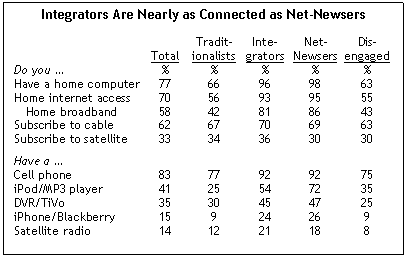
Net-Newsers (13% of the population) are the most male group (58% male). They are highly educated, affluent and relatively young (median age: 35). Politically, Net-Newsers include the greatest share of independents (35%) of the three news audience segments. Notably, a relatively large proportion also describes themselves as liberal (24%).
Beyond their news consumption, Net-Newsers are significantly more active on the web than are the other news audience segments. Nearly half (46%) have social-networking profiles, and 59% are connected to the web while at work. Almost three-quarters (72%) own MP3 players, and they own other technologies at high rates.

Disengaged (14% of the population) are the least affluent (35% say their annual income is less than $30,000) and the least educated (69% have not attended college). More than six-in-ten of the Disengaged (61%) are women. They also are relatively uninterested in politics: 23% decline to describe themselves in political terms (as a Democrat, Republican or independent; similarly, 26% choose not to characterize themselves ideologically (as liberal, conservative, or moderate).
Time with the News
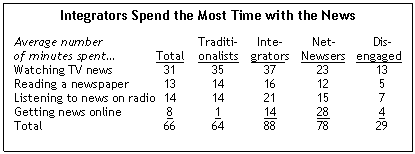
People who have incorporated the internet into their news diets – especially the Integrators – are heavier news consumers than are the Traditionalists. On a typical day, Integrators spend an average of 88 minutes on the news, compared with 78 minutes for Net-Newsers and 64 minutes for Traditionalists.
In other ways, Integrators stand out as the most avid news consumers of the three core audience segments. Integrators use all traditional sources at the highest rates, and a solid majority (56%) reports getting news online the previous day. For the Integrators, it is not just using the internet as well as traditional sources: they also spend more time watching TV news, reading the paper, and especially getting the news on the radio than either of the other core audience segments. Just 8% of Integrators get no news on a typical day, and most (70%) report getting news from two or more sources.

Net-Newsers are, first and foremost, online news consumers. Fully 75% get news online in a typical day. But their reliance on the web for news does not signal a wholesale rejection of traditional sources; almost as many (72%) say they used a traditional source yesterday, and their use of some traditional sources rivals that of other groups. In particular, Net-Newsers read newspapers at about the same rate as the Traditionalists and are slightly more likely to get radio news on a typical day.
However, even in their use of newspapers, the Net-Newsers’ preference for the web is apparent. While 35% reported reading a newspaper yesterday, as many as one quarter of the Net-Newsers who do read a paper either read only the online version or the print and online papers.
The Traditionalists are about as likely as the Integrators to watch TV news or read a newspaper on a typical day. But very few – just 7% – use the internet for news, despite the fact that most have home internet access. About twice as many of the Disengaged got news online on the previous day as did the Traditionalists (13% vs. 7%).
Regular News Sources

Broadcast news sources are popular with Traditionalists and Integrators, who are about equally likely to say they regularly watch local TV news, nightly network news and network morning shows. By contrast, just 35% of Net-Newsers say they regularly watch local TV news – a staple for 61% of Traditionalists and Integrators. And only about half the number of Net-Newsers tune into a nightly network news broadcast compared with Traditionalists or Integrators.
However, Net-Newsers are more inclined to use traditional media sources that are not scheduled in the same way as network and local TV news, such as newspapers and cable news. Cable news, in particular, is a relatively popular news source for this group: 43% watch regularly, about the same percentage as among the Traditionalists (41%).
In addition, there are a handful of specific news outlets – including NPR and the BBC – that Net-Newsers use at equal or greater rates than the Integrators. Fully 11% of Net-Newsers report that they regularly get news from the BBC (either through radio, television, or the internet), while just 6% of Integrators regularly get news from the BBC. The same proportion of Integrators and Net-Newsers (15%) regularly gets news from NPR.
Net-Newsers also read business (12%), technology (12%) and weekly news (16%) magazines at relatively high rates. The use of these types of sources is in line with this segment’s interest in science and technology news, business and financial news and international affairs.
Getting News Online
Net-Newsers’ use of online news sources equals – and in some cases surpasses -their use of traditional news media sources. Within this segment, 30% report that they regularly watch news programs or video clips online, which is significantly more than the number saying they regularly watch the nightly network news (18%).

News and political blog readership is also high among Net-Newsers–more than a quarter (26%) say that they regularly get news from blogs.
Further, this segment is more likely to engage in online news behaviors that require them to actively seek out news: 24% use a search engine to find news stories every day, 10% use news ranking sites, and more than a quarter (27%) report having sent news emails to friends or family in the previous week.
Many Integrators engage in these online news activities, but they do so at significantly lower rates than do the Net-Newsers. Integrators are about half as likely to watch (16% to 30%) or listen to (10% to 19%) news online and are much less likely than Net-Newsers to actively seek news online. However, nearly one-in-five Integrators (19%) regularly read blogs, which is only a slightly smaller proportion than among Net-Newsers (26%).
News During the Day
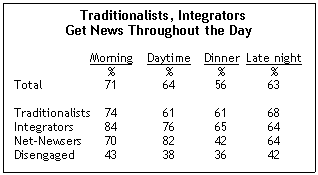
Integrators spend more time with the news overall, and they are more likely than the other audience segments to get news in the morning. Fully 84% of Integrators typically get news in the morning, while 76% get news during the course of the day, and nearly two-thirds get news around the dinner hour (65%) and late in the evening (64%).
Traditionalists are more likely to get news in the morning than at other times (74%), but six-in-ten get news during the day (61%), around the dinner hour (61%), and late in the evening (68%). By contrast, news consumption among Net-Newsers peaks during the day, when 82% say they get news, and declines to just half of that level (42%) around the dinner hour.
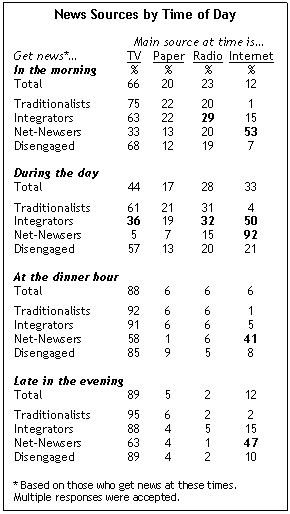
Net-Newsers show a clear preference for online news over television news in the morning and during the day. A majority of Net-Newsers (53%) who get news to start the day get it from the web, while just 33% turn to television. Additionally, 92% of those who get news during the day – which is the most popular time of day for Net-Newsers to get news – go online for it.
Even around the dinner hour and late in the evening – times when television news is the dominant source for other audience segments -significant minorities of Net-Newsers continue to rely on the internet (41% at the dinner hour and 47% late at night). However, during those times more Net-Newsers get news from television than online.
Integrators, by contrast, rely primarily on traditional sources throughout the day, as do the Traditionalists. Where Integrators differ is in their relatively extensive use of the internet for news during the day. Half of integrators who get news at that time go online, while 36% get news from television, and nearly as many (32%) get news from radio.
Check in vs. Appointment News

Distinct differences also are apparent in how the segments schedule news into life. A majority of Traditionalists (56%) and Integrators (53%) get their news at regular times; in contrast, only 20% of Net-Newsers say that their news consumption adheres to a regular schedule.
Nonetheless, nearly a third of all Integrators (32%) say they check in on the news several times a day, just slightly less than the proportion of Net-Newsers who say they do that (40%). By contrast, just 22% of Traditionalists say they check in on the news several times a day.
General News Interests
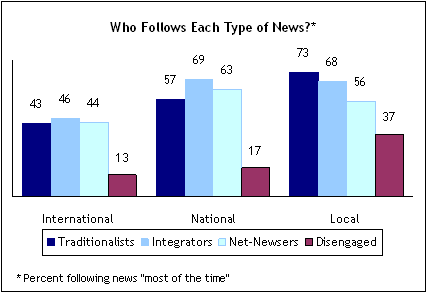
Nearly seven-in-ten Integrators (69%) say they follow national news most of the time and not only when important events occur. That compares with 63% of Net-Newsers and a smaller majority of Traditionalists (57%).
By contrast, traditionalists express more consistent interest in local news. Nearly three-quarters of Traditionalists (73%) follow local news closely most of the time; just 56% of Net-Newsers say the same.
All three core news audience segments express less interest in international news than in local or national news. Comparable percentages in each core group say they follow international news most of the time rather than just when important news occurs.
Interest in Specific News Topics
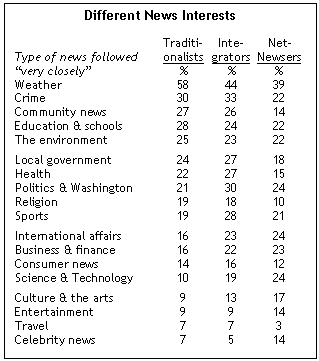
Integrators’ avid interest in the news is apparent in how closely they follow a variety of specific news topics. With the exception of weather news, Integrators match or exceed Traditionalists’ levels of interest in almost every subject included on the survey.
Integrators also follow a greater number of subjects – including community and local government news, and coverage of politics and Washington – than do Net-Newsers. By comparison, more Net-Newsers than Traditionalists follow news about culture and the arts, celebrity news, and coverage of science and technology.
For their part, Traditionalists express greater interest in several close-to-home news topics than they do in national politics or international affairs. While weather is a top news draw across audience segments, Traditionalists stand out for their strong interest in the weather; 58% follow weather news very closely. In addition, more Traditionalists say they follow community news very closely (27%) than say the same about news about politics and Washington (21%) or international news (16%).
Attitudes about the News

Integrators, by many measures the most avid consumers of news, are the most likely to hold positive attitudes about the news. About two-thirds of Integrators (68%) derive a great deal of enjoyment from keeping up with the news, and a similar proportion (66%) enjoy having news on in the background. Integrators also have the easiest time incorporating the news into their lives: Fully 77% say it is “pretty easy” to do so.
Majorities of all three core segments contend that they do not feel overloaded with the amount of news today. But this is particularly the case for Net-Newsers; 68% say they do not feel overloaded by the amount of news available today, compared with 60% of Integrators and 56% of Traditionalists.
Net-Newsers and Integrators are the most selective in their media use; 66% and 69%, respectively, say they trust some news media more than others. Traditionalists, by contrast, are more evenly split on this question, with 47% saying all the news media is pretty much the same. This is particularly notable given the great variety of sources that Net-Newsers and Integrators use.

Consistent with their greater reliance on newspapers, radio, and the internet, majorities of both Net-Newsers (58%) and Integrators (54%) say they prefer reading or hearing about the news to seeing pictures and video. By contrast, a majority of Traditionalists (51%) – the only segment that spends the majority of its news time with television news – express a preference for video or pictures.
Knowledge and Audience Segments

Integrators and Net-Newsers are the most politically knowledgeable of the audience segments. Greater proportions of these groups were able to correctly answer three knowledge questions than either the Traditionalists or the general public. As might be expected, the Disengaged fared considerably worse than the other groups in terms of political knowledge.
Comparable-sized majorities of Integrators and Net-Newsers know that Democrats have a majority in the House of Representatives (68% each), and that Condoleezza Rice is the Secretary of State (60% Integrators, 56% Net-Newsers). Smaller percentages in both groups could identify Gordon Brown as the Prime Minister of Great Britain (40% Net-Newsers, 38% Integrators). The same proportions of Integrators and Net-Newsers answered all three questions correctly (29%).
A majority of Traditionalists (52%) know that Democrats control the House, but far fewer could name Rice (38%) or Brown (26%). The Disengaged’s lack of interest in news is apparent in their news-related knowledge: few correctly answered any individual item, and just 2% could answer all three.




